Yes you need to allow that
04.04.2025 02:55 — 👍 2 🔁 0 💬 0 📌 0
Prompts: aistudio.google.com/prompts/1uwR...
The example app given in the first prompt: github.com/multisynq/mu...
04.04.2025 02:29 — 👍 1 🔁 0 💬 1 📌 0
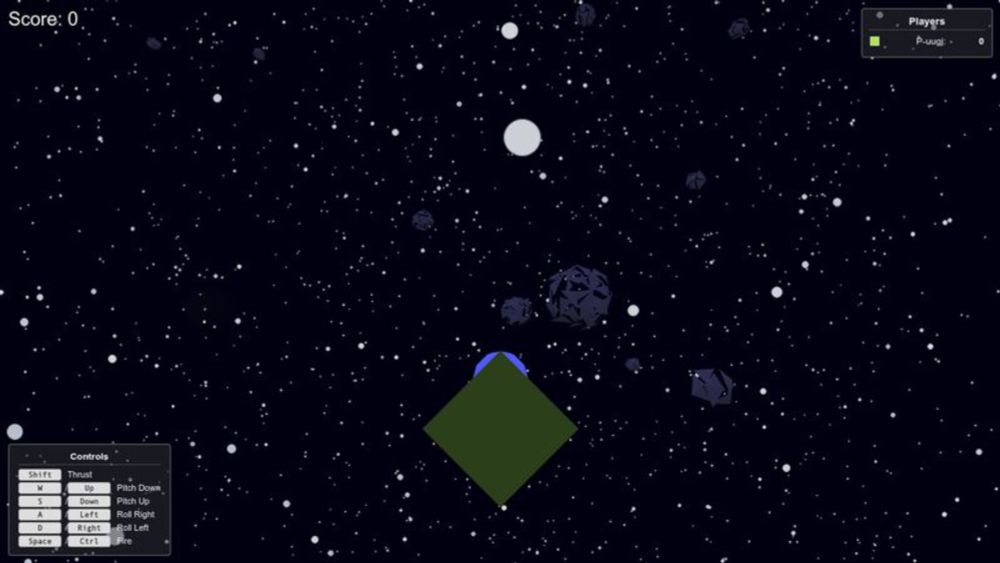
Multi-player 3D Asteroids using Three.js & Croquet vibe coded by Gemini
...
I spent an afternoon vibe-coding a multiplayer game with @multisynq.bsky.social and @threejs.org using Gemini Pro 2.5 – 100% AI coded, although I had to explain how to correct the errors. Zero server code, client-side multiplayer.
Live and source on @codepen.io:
codepen.io/codefrau/ful...
04.04.2025 02:28 — 👍 3 🔁 0 💬 1 📌 0
The docs are so pretty, OMG. Congrats!
03.04.2025 17:39 — 👍 3 🔁 0 💬 0 📌 0
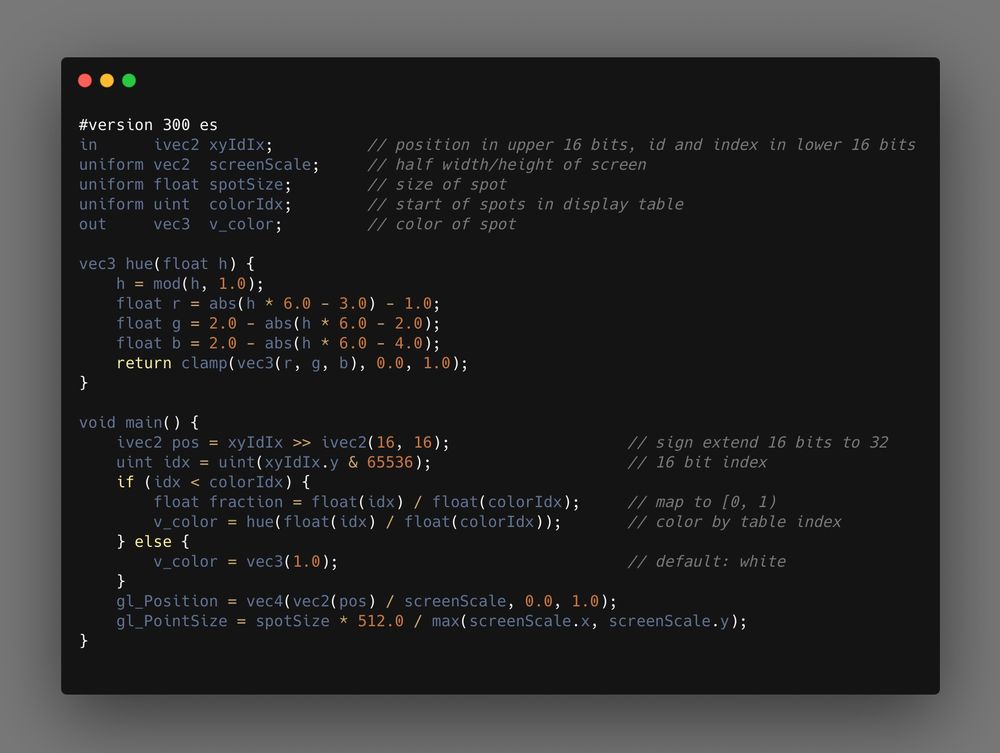
#version 300 es
in ivec2 xyIdIx; // position in upper 16 bits, id and index in lower 16 bits
uniform vec2 screenScale; // half width/height of screen
uniform float spotSize; // size of spot
uniform uint colorIdx; // start of spots in display table
out vec3 v_color; // color of spot
vec3 hue(float h) {
h = mod(h, 1.0);
float r = abs(h * 6.0 - 3.0) - 1.0;
float g = 2.0 - abs(h * 6.0 - 2.0);
float b = 2.0 - abs(h * 6.0 - 4.0);
return clamp(vec3(r, g, b), 0.0, 1.0);
}
void main() {
ivec2 pos = xyIdIx >> ivec2(16, 16); // sign extend 16 bits to 32
uint idx = uint(xyIdIx.y & 65536); // 16 bit index
if (idx < colorIdx) {
float fraction = float(idx) / float(colorIdx); // map to [0, 1)
v_color = hue(float(idx) / float(colorIdx)); // color by table index
} else {
v_color = vec3(1.0); // default: white
}
gl_Position = vec4(vec2(pos) / screenScale, 0.0, 1.0);
gl_PointSize = spotSize * 512.0 / max(screenScale.x, screenScale.y);
}
You wouldn’t believe how long it took me to find my very obvious typo 🤦🏻♀️
The symptom was that the output looked red and white 🔴⚪️ when it was supposed to be rainbowey 🌈
16.03.2025 05:36 — 👍 2 🔁 0 💬 0 📌 0
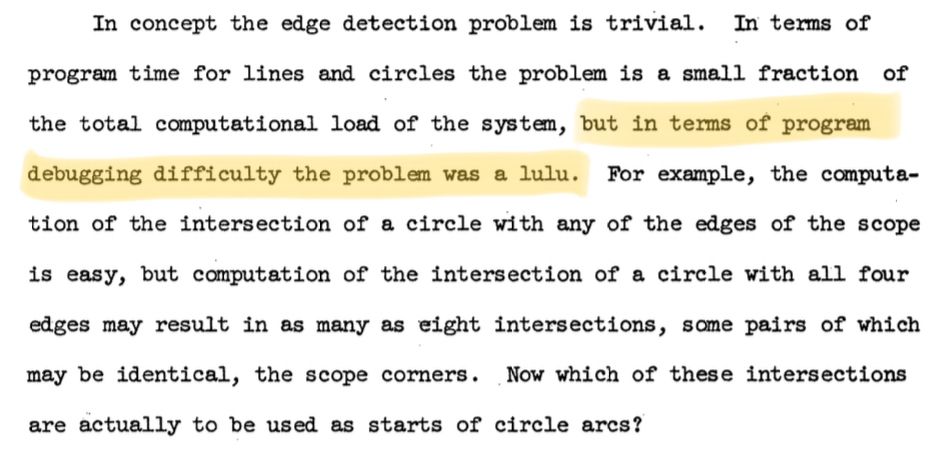
In concept the edge detection problem is trivial. In terms of program time for lines and circles the problem is a small fraction of the total computational load of the system, but in terms of program debugging difficulty the problem was a lulu. For example, the computation of the intersection of a circle with any of the edges of the scope is easy, but computation of the intersection of a circle with all four edges may result in as many as eight intersections, same pairs of which maybe identical, the scope corners. Now which of these intersections are actually to be used as starts of circle arcs?
“in terms of program debugging difficulty the problem
was a lulu.”
— Ivan Sutherland (1963!), “Sketchpad,” pg. 76
12.03.2025 03:53 — 👍 1 🔁 0 💬 0 📌 0
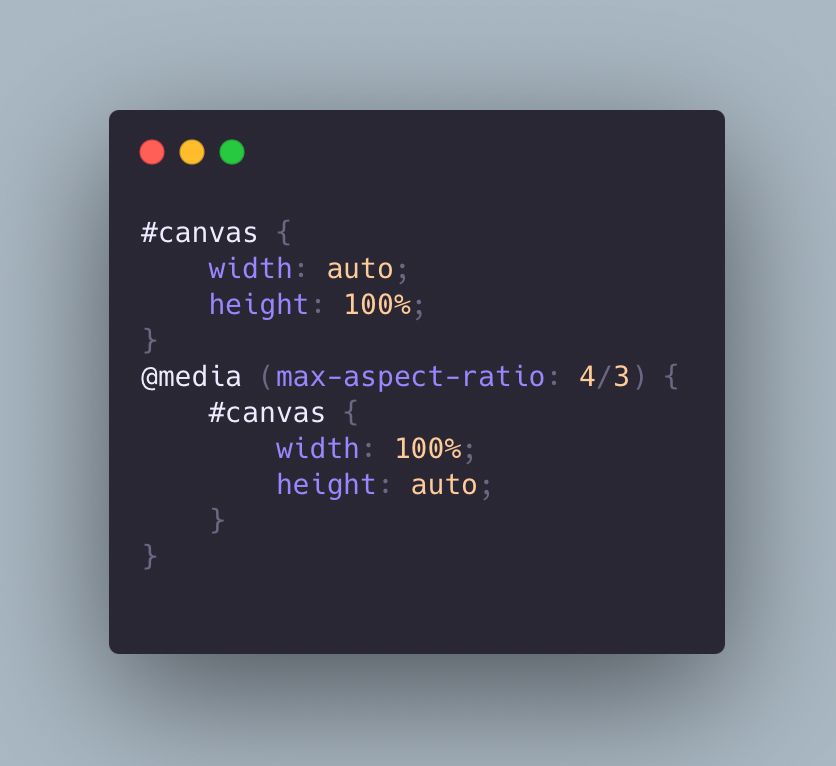
#canvas {
width: auto;
height: 100%;
}
@media (max-aspect-ratio: 4/3) {
#canvas {
width: 100%;
height: auto;
}
}
I figured out how to keep my fixed-aspect canvas centered but as-large-as-possible in pure CSS 🥳
(I didn’t want to use object-fit because it distorts JS event positions)
Try it here (resize the window or turn your phone) codefrau.github.io/Smalltalk78/...
06.03.2025 19:35 — 👍 1 🔁 0 💬 0 📌 0
Thank you
04.03.2025 08:27 — 👍 0 🔁 0 💬 0 📌 0
𝗖𝗼𝗱𝗲𝗳𝗿𝗮𝘂
𝘾𝙤𝙙𝙚𝙛𝙧𝙖𝙪
𝘊𝘰𝘥𝘦𝘧𝘳𝘢𝘶
CODEFRAU
ᴄᴏᴅᴇꜰʀᴀᴜ
ᶜᵒᵈᵉᶠʳᵃᵘ
ℭ𝔬𝔡𝔢𝔣𝔯𝔞𝔲
𝕮𝖔𝖉𝖊𝖋𝖗𝖆𝖚
𝙲𝙾𝙳𝙴𝙵𝚁𝙰𝚄
ᑕOᗪEᖴᖇᗩᑌ
𝓒𝓞𝓓𝓔𝓕𝓡𝓐𝓤
🅒🅞🅓🅔🅕🅡🅐🅤
🅲🅾🅳🅴🅵🆁🅰🆄
ⒸⓄⒹⒺⒻⓇⒶⓊ
🄲🄾🄳🄴🄵🅁🄰🅄
25.02.2025 00:41 — 👍 3 🔁 0 💬 0 📌 0
I see we had the same idea. Nice!
18.02.2025 23:25 — 👍 2 🔁 0 💬 0 📌 0
In a way I like this best because it’s straightforward to explain:
* No damage? Nice, shield doesn’t break
* This attack breaks the shield? Okay, return the number of this attack
* Otherwise, this attack does damage, and we look at the next attack
I’ll admit that “straightforward” is … subjective 😇
18.02.2025 23:19 — 👍 2 🔁 0 💬 0 📌 0
![findShieldBreak = (dmgs, shld, pos=0) =>
dmgs.length == 0 ? -1
: shld <= dmgs[0] ? pos
: findShieldBreak(dmgs.slice(1), shld - dmgs[0], pos + 1)](https://cdn.bsky.app/img/feed_thumbnail/plain/did:plc:4rblvl6kpkrlmnctjzgoq7ar/bafkreigkmjovfcnzbwyslkgjtkcrwgmz4asaulmcsyh6s4ygmg42bhnswa@jpeg)
findShieldBreak = (dmgs, shld, pos=0) =>
dmgs.length == 0 ? -1
: shld <= dmgs[0] ? pos
: findShieldBreak(dmgs.slice(1), shld - dmgs[0], pos + 1)
Played a bit more – recursion is fun!
👸🏻🛡️
🐢🐢🐢
🐢🐢
🐢
💃🏻
codepen.io/codefrau/pen...
18.02.2025 06:31 — 👍 1 🔁 0 💬 1 📌 0
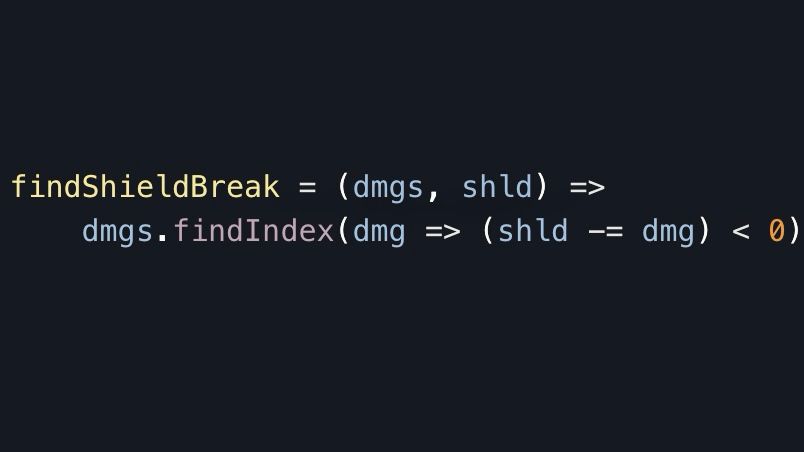
findShieldBreak = (dmgs, shld) =>
dmgs.findIndex(dmg => (shld -= dmg) < 0)
findShieldBreak = (dmgs, shld) =>
dmgs.findIndex(dmg => (shld -= dmg) < 0)
👸🏻🛡️🔥🔥🔥🐉
codepen.io/codefrau/pen...
17.02.2025 10:02 — 👍 4 🔁 0 💬 2 📌 0
Especially using single digit numbers to avoid having to tokenize was brilliant. It let us focus on the actual problem instead of incidental complexity
10.02.2025 21:15 — 👍 1 🔁 0 💬 0 📌 0
It’s not very readable, admittedly, even though it’s very succinct. But whittling it down to almost a one-liner was a fun exercise. Thank you for the prompt!
10.02.2025 21:12 — 👍 2 🔁 0 💬 1 📌 0
Okay now that I’ve seen all the other submissions I wonder if an actual interviewer would object to my use of `eval()`. Then again, the `splice(-2)` is neat to get the operands in the right order for sub/div. They should appreciate that
10.02.2025 06:38 — 👍 2 🔁 0 💬 2 📌 0
It’s been a while, yes, but I’m still reading your letter every week. One of the few highlights right now 💜
04.02.2025 22:57 — 👍 1 🔁 0 💬 0 📌 0
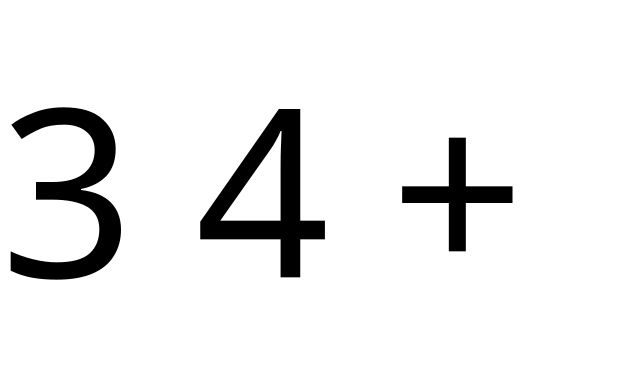
Reverse Polish notation - Wikipedia
It’s how you combine subexpressions in RPN (see en.m.wikipedia.org/wiki/Reverse...)
Try this:
evaluatePostfix('123*+123++*')
04.02.2025 20:28 — 👍 3 🔁 0 💬 0 📌 0
Clever! But evaluatePostfix('123++') should be 6 🤓
04.02.2025 20:13 — 👍 2 🔁 0 💬 1 📌 0
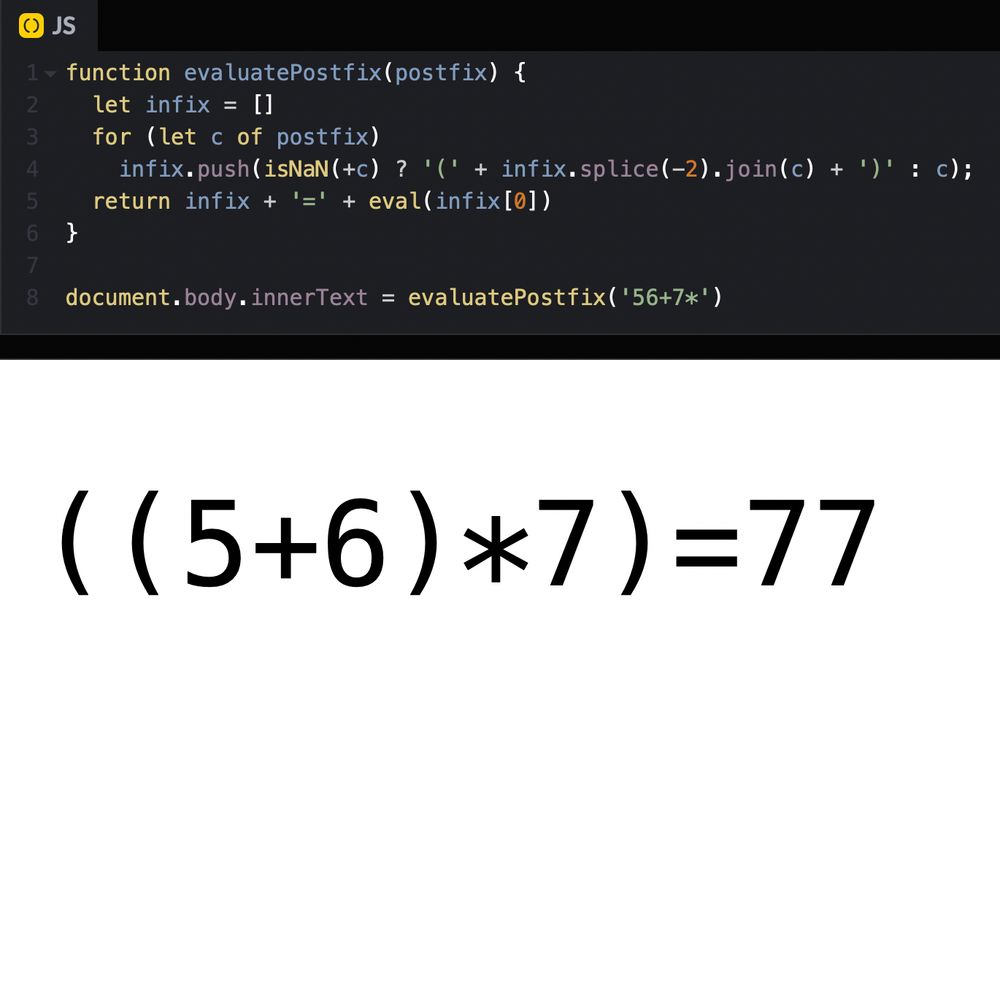
Screenshot of the codepen and its output
That was fun!
function evaluatePostfix(s) {
let a = []
for (let c of s)
a.push(isNaN(+c) ? eval(a.splice(-2).join(c)) : c);
return a.pop()
}
My CodePen does the infix conversion first and evals at the end:
codepen.io/codefrau/pen...
04.02.2025 19:49 — 👍 5 🔁 0 💬 2 📌 0
This is one of the many awesome projects you can play with at squeak.js.org/etoys/ which has the 2005 version of Etoys running on my virtual machine.
It’s in the Project Gallery (3rd row, 3rd item)
28.01.2025 21:01 — 👍 3 🔁 0 💬 0 📌 0

Selfie of me smiling into the camera with asymmetric, purple hair, matching purple lipstick and glasses, in a navy summer dress with small flower ornaments, a golden necklace with a V pendant sitting on a bench in front of an ivy-covered wall
Trying a new profile picture
www.instagram.com/p/CvqRxdlPGsg/
28.11.2024 23:37 — 👍 2 🔁 0 💬 0 📌 0
Ohhhhh amazing list 😍
28.11.2024 18:02 — 👍 1 🔁 0 💬 0 📌 0
Thank you for this Award, and congrats to my co-authors! It’s been an incredible 10 years.
Check out SqueakJS at squeak.js.org
14.11.2024 00:42 — 👍 10 🔁 1 💬 0 📌 0
Professor. Sociologist. NYTimes Opinion Columnist. Books: THICK, LowerEd. Forthcoming: 1)Black Mothering & Daughtering and 2)Mama Bears.
Beliefs: C.R.E.A.M. + the internet ruined everything good + bring back shame.
“I’m just here so I don’t get fined.”
Deaf-mute • Ex Google/Uber/AirBnB/Lyft
BS(AEM) from Cornell | MBA from Wharton
Daily Stories on history’s forgotten female Inventors, Discoverers & Leaders • San Francisco, California 🇺🇸
Making 3D easier since 2010.
The Missing Protocol of the Internet
Personal Account
Founder: The Distributed AI Research Institute @dairinstitute.bsky.social.
Author: The View from Somewhere, a memoir & manifesto arguing for a technological future that serves our communities (to be published by One Signal / Atria
•Femme Lesbian •Weirdo •UnpaidComedian •Feminist •Sober •Social Justice Freak •Femme Solidarity •Butch-Femme Lyfe🖤🌈
JD | MPH
Political Snarkologist
Host of The Joy Reid Show, best-selling author, writer, documentary filmmaker, and happy warrior blerd 'bout town. Subscribe at thejoyreidshow.com and joyannreid.com!
5’10 criminal mastermind, transylvanian music snob
hail satan & eat the rich
⸸ east van ⸸
The young person's guide to conquering (and saving) the world.✨
Sign up for our politics newsletter: http://tnvge.co/PZWnEym
.𖥔 ݁ ˖ therapist just tryina thrive in an apocalypse and figuring it out along with u
𖡎 Cycling and nature
♡ ̆̈ Ceramics & arts
❣️ in 🇵🇷 but 📍in LA
Digital Smartiskirt. Vibe Code Data Cleanup Specialist. Data Platform MVP. MCT. Space Exploration fan. VR4 fan. Available for contract projects
🇺🇸GONE FISHING 🎣
WANT TO COLLAB?
OfficialCampCallout@gmail.com
Amanda Katz said this was the cool kids table.
We bolster the metaverse as an open and interoperable resource for anyone, inspired by the collaborative efforts of the community. Whatever the metaverse means to you, we have space for you.
The queer porn that started it all! CrashPad is a long-running LGBTQ+ adult film studio created by Shine Louise Houston, now directed by Ava LaPrima. QT+BIPOC owned + operated! Crash with us.
CrashPadSeries.com




![findShieldBreak = (dmgs, shld, pos=0) =>
dmgs.length == 0 ? -1
: shld <= dmgs[0] ? pos
: findShieldBreak(dmgs.slice(1), shld - dmgs[0], pos + 1)](https://cdn.bsky.app/img/feed_thumbnail/plain/did:plc:4rblvl6kpkrlmnctjzgoq7ar/bafkreigkmjovfcnzbwyslkgjtkcrwgmz4asaulmcsyh6s4ygmg42bhnswa@jpeg)



